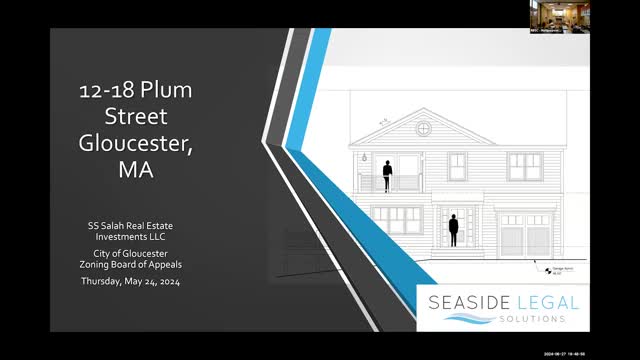Zoning Variance Sparks Controversy Over New Home Construction
July 24, 2024 | Gloucester City, Essex County, Massachusetts

This article was created by AI summarizing key points discussed. AI makes mistakes, so for full details and context, please refer to the video of the full meeting. Please report any errors so we can fix them. Report an error »

In a recent government meeting, discussions centered around a proposed residential development that seeks to address zoning challenges in a neighborhood characterized by a mix of single and two-family homes. The proposal involves the construction of a single-family home on a merged property that previously housed a two-family structure, which was rebuilt after a fire in 2013.
The property in question consists of two parcels that have merged due to zoning regulations, resulting in a single lot that is undersized for the intended residential density. The applicant is requesting a variance to allow the new single-family home to stand alone, as current zoning ordinances prohibit more than one principal dwelling on the lot unless they are physically connected.
The proposed single-family home is designed to meet all dimensional requirements, including setbacks and height restrictions. The structure will be set back 26 feet from the road, exceeding the required 20-foot setback, and will maintain a significant distance from neighboring properties. The applicant emphasized that the new home would contribute to the neighborhood's character while addressing the ongoing housing crisis.
Despite the proposal's alignment with local zoning standards, the variance request is necessitated by a specific footnote in the zoning ordinance. The applicant argued that alternative configurations, such as connecting the new home to the existing two-family structure via breezeways, would not only be impractical but would also detract from the neighborhood's aesthetic.
The meeting revealed a mix of community sentiment, with some neighbors supporting the project while others expressed opposition. The applicant highlighted that the proposed development would not harm the public good or undermine the intent of the zoning ordinance, asserting that the existing two-family home and the new single-family residence would maintain one of the least dense properties in the area.
As the city grapples with a housing shortage, the outcome of this variance request could set a precedent for similar developments in the future, balancing the need for additional housing with adherence to zoning regulations. The board's decision will ultimately determine whether this project can move forward, reflecting broader challenges in urban planning and community development.
The property in question consists of two parcels that have merged due to zoning regulations, resulting in a single lot that is undersized for the intended residential density. The applicant is requesting a variance to allow the new single-family home to stand alone, as current zoning ordinances prohibit more than one principal dwelling on the lot unless they are physically connected.
The proposed single-family home is designed to meet all dimensional requirements, including setbacks and height restrictions. The structure will be set back 26 feet from the road, exceeding the required 20-foot setback, and will maintain a significant distance from neighboring properties. The applicant emphasized that the new home would contribute to the neighborhood's character while addressing the ongoing housing crisis.
Despite the proposal's alignment with local zoning standards, the variance request is necessitated by a specific footnote in the zoning ordinance. The applicant argued that alternative configurations, such as connecting the new home to the existing two-family structure via breezeways, would not only be impractical but would also detract from the neighborhood's aesthetic.
The meeting revealed a mix of community sentiment, with some neighbors supporting the project while others expressed opposition. The applicant highlighted that the proposed development would not harm the public good or undermine the intent of the zoning ordinance, asserting that the existing two-family home and the new single-family residence would maintain one of the least dense properties in the area.
As the city grapples with a housing shortage, the outcome of this variance request could set a precedent for similar developments in the future, balancing the need for additional housing with adherence to zoning regulations. The board's decision will ultimately determine whether this project can move forward, reflecting broader challenges in urban planning and community development.
View full meeting
This article is based on a recent meeting—watch the full video and explore the complete transcript for deeper insights into the discussion.
View full meeting
